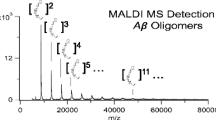Summary
Aβ peptides are now acknowledged to play a central role in the pathogenesis of Alzheimer’s disease. Their generation results from the sequential cleavage of amyloid precursor protein by β and γ secretases. The resulting peptide fragments impart toxicity via their ability to form soluble oligomers and bind to cell membranes. In this chapter we describe the use of ProteinChip ® technology to study the physicochemical behaviour of Aβ and its mechanisms of toxicity. These include analyzing (1) Aβ processing and quantitation of peptide fragments, (2) Aβ aggregation and the quantitation of oligomers, and (3) Aβ–lipid interactions.
Access this chapter
Tax calculation will be finalised at checkout
Purchases are for personal use only
Similar content being viewed by others
References
Gorevic, P.D., Goni, F., Pons-Estel, B., Alvarez, F., Peress, N.S. and Frangione, B. (1986) Isolation and partial characterization of neurofibrillary tangles and amyloid plaque core in Alzheimer’s disease: immunohistological studies. J. Neuropathol. Exp. Neurol. 45, 647–664.
Masters, C.L., Simms, G., Weinman, N.A., Multhaup, G., McDonald, B.L. and Beyreuther, K. (1985) Amyloid plaque core protein in Alzheimer disease and Down syndrome. Proc. Natl. Acad. Sci. USA 82, 4245–4249.
Selkoe, D.J. (2001) Alzheimer’s disease: genes, proteins, and therapy. Physiol. Rev. 81, 741–766.
Sisodia, S.S. and St George-Hyslop, P.H. (2002) Gamma-Secretase, Notch, Abeta and Alzheimer’s disease: where do the presenilins fit in? Nat. Rev. Neurosci. 3,281–290.
Sisodia, S.S., Koo, E.H., Beyreuther, K., Unterbeck, A. and Price, D.L. (1990) Evidence that beta-amyloid protein in Alzheimer’s disease is not derived by normal processing. Science 248, 492–495.
Haass, C., Hung, A.Y., Schlossmacher, M.G., Teplow, D.B. and Selkoe, D.J. (1993) beta-Amyloid peptide and a 3-kDa fragment are derived by distinct cellular mechanisms. J. Biol. Chem. 268, 3021–3024.
Jarrett, J.T., Berger, E.P. and Lansbury, Jr. P.T. (1993) The carboxy terminus of the beta amyloid protein is critical for the seeding of amyloid formation: implications for the pathogenesis of Alzheimer’s disease. Biochemistry 32, 4693–4697.
Lesne, S., Koh, M.T., Kotilinek, L., et al. (2006) A specific amyloid-beta protein assembly in the brain impairs memory. Nature 440, 352–357.
Harper, J.D., Wong, S.S., Lieber, C.M. and Lansbury, P.T. (1997) Observation of metastable Abeta amyloid protofibrils by atomic force microscopy. Chem. Biol. 4, 119–125.
Relini, A., Torrassa, S., Rolandi, R., et al. (2004). Monitoring the process of HypF fibrillization and liposome permeabilization by protofibrils. J. Mol. Biol. 338,943–957.
Hartley, D.M., Walsh, D.M., Ye, C.P., et al. (1999) Protofibrillar intermediates of amyloid beta-protein induce acute electrophysiological changes and progressive neurotoxicity in cortical neurons . J. Neurosci. 19, 8876–8884.
Behl, C., Davis, J.B., Lesley, R. and Schubert, D. (1994) Hydrogen peroxide mediates amyloid beta protein toxicity. Cell 77, 817–827.
Ambroggio, E.E., Kim, D.H., Separovic, F., et al. (2005) Surface behavior and lipid interaction of Alzheimer beta-amyloid peptide 1–42: a membrane-disrupting peptide. Biophys. J. 88, 2706–2713.
Mattson, M.P., Cheng, B., Davis, D., Bryant, K., Lieberburg, I. and Rydel, R.E. (1992) beta-Amyloid peptides destabilize calcium homeostasis and render human cortical neurons vulnerable to excitotoxicity. J. Neurosci. 12, 376–389.
Curtain, C.C., Ali, F., Volitakis, I., et al. (2001) Alzheimer’s disease amyloid-beta binds copper and zinc to generate an allosterically ordered membrane-penetrating structure containing superoxide dismutase-like subunits. J. Biol. Chem. 276,20466–20473.
Dong, J., Atwood, C.S., Anderson, V.E., et al. (2003) Metal binding and oxidation of amyloid-beta within isolated senile plaque cores: Raman microscopic evidence. Biochemistry 42, 2768–2773.
Pike, C.J., Walencewicz-Wasserman, A.J., Kosmoski, J., Cribbs, D.H., Glabe, C.G. and Cotman, C.W. (1995) Structure-activity analyses of beta-amyloid peptides: contributions of the beta 25–35 region to aggregation and neurotoxicity. J. Neurochem. 64, 253–265.
Arispe, N., Rojas, E. and Pollard, H.B. (1993) Alzheimer disease amyloid beta protein forms calcium channels in bilayer membranes: blockade by tromethamine and aluminum. Proc. Natl. Acad. Sci. USA 90, 567–571.
Guo, Q., Fu, W., Xie, J., et al. (1998) Par-4 is a mediator of neuronal degeneration associated with the pathogenesis of Alzheimer disease. Nat. Med. 4, 957–962.
Wiesner, A. (2004) Detection of tumor markers with ProteinChip technology. Curr. Pharm. Biotechnol. 5, 45–67.
Austen, B.M., Frears, E.R. and Davies, H. (2000) The use of seldi proteinchip arrays to monitor production of Alzheimer’s betaamyloid in transfected cells. J. Pept. Sci. 6, 459–469.
Bradbury, L.E., LeBlanc, J.F. and McCarthy, D.B. (2004) ProteinChip array-based amyloid beta assays. Methods Mol. Biol. 264, 245–257.
Maddalena, A.S., Papassotiropoulos, A., Gonzalez-Agosti, C., et al. (2004) Cerebrospinal fluid profile of amyloid beta peptides in patients with Alzheimer’s disease determined by protein biochip technology. Neurodegener. Dis. 1,231–235.
Bitan, G., Lomakin, A. and Teplow, D. B. (2001) Amyloid beta-protein oligomerization: prenucleation interactions revealed by photo-induced cross-linking of unmodified proteins. J. Biol. Chem. 276, 35176–35184.
Pirttilä, T., Kim, K.S., Mehta, P.D., Frey, H. and Wisniewski, H.M. (1994) Soluble amyloid β-protein in the cerebrospinal fluid from patients with Alzheimer’s disease, vascular dementia and controls. J. Neurol. Sci. 127, 90–95.
Ida, N., Hartmann, T., Pantel, J., et al. (1996) Analysis of heterogeneous A4 peptides in human cerebrospinal fluid and blood by a newly developed sensitive Western blot assay. J. Biol. Chem. 271, 22908–22914.
Jensen, M., Hartmann, T., Engvall, B., et al. (2000) Quantification of Alzheimer amyloid beta peptides ending at residues 40 and 42 by novel ELISA systems. Mol. Med. 6, 291–302.
Barelli, H., Lebeau, A., Vizzavona, J., et al. (1997) Characterization of new polyclonal antibodies specific for 40 and 42 amino acid-long amyloid beta peptides: their use to examine the cell biology of presenilins and the immunohistochemistry of sporadic Alzheimer’s disease and cerebral amyloid angiopathy cases. Mol. Med. 3, 695–707.
Author information
Authors and Affiliations
Editor information
Editors and Affiliations
Rights and permissions
Copyright information
© 2008 Humana Press, a part of Springer Science+Business Media, LLC
About this protocol
Cite this protocol
Giannakis, E., Hung, LW., Camacaro, K.P., Smith, D.P., Barnham, K.J., Wade, J.D. (2008). Analysis of Aβ Interactions Using ProteinChip Technology. In: Otvos, L. (eds) Peptide-Based Drug Design. Methods In Molecular Biology™, vol 494. Humana Press. https://doi.org/10.1007/978-1-59745-419-3_5
Download citation
DOI: https://doi.org/10.1007/978-1-59745-419-3_5
Publisher Name: Humana Press
Print ISBN: 978-1-58829-990-1
Online ISBN: 978-1-59745-419-3
eBook Packages: Springer Protocols




